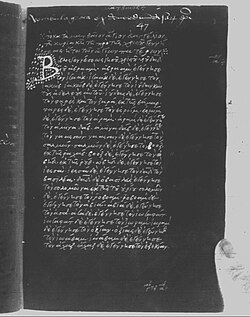New Testament manuscript
| New Testament manuscript | |
 The beginning of the Gospel of Matthew The beginning of the Gospel of Matthew | |
| Text | Gospels |
|---|---|
| Date | 15th century |
| Script | Greek |
| Now at | Lincoln College, Oxford |
| Size | 20.5 cm by 14.5 cm |
| Type | Byzantine |
| Category | none |
| Note | close to codex 54 |
Minuscule 56 (in the Gregory-Aland numbering), ε 517 (von Soden), is a Greek minuscule manuscript of the New Testament, on paper leaves. Palaeographically it has been assigned to the 15th century. The manuscript has complex contents and some marginalia.
Description
The codex contains complete text of the four Gospels on 232 paper leaves (size 20.5 cm by 14.5 cm). The text is written in one column per page, 24 lines per page.
The text is divided according to the κεφαλαια (chapters), whose numbers are given at the margin (also in Latin), with some τιτλοι (titles of chapters) at the top of the pages.
It contains Prolegomena to the Gospel of Mark and Luke, lists of the κεφαλαια (tables of contents) before each Gospel, αναγνωσεις (lessons), titles to the Gospels, subscriptions at the end of each Gospel, with numbers of στιχοι (only in John), and numbered paragraphs.
Text
The Greek text of the codex is a representative of the Byzantine text-type. Hermann von Soden classified it to the textual family K. Aland did not assign it to any Category of New Testament manuscripts. According to the Claremont Profile Method it represents the textual family K in Luke 1, Luke 10, and Luke 20. It creates a textual cluster with 58. This means it has a Byzantine text.
The text contains some various readings. According to C. R. Gregory it is a sister or daughter of the codex 54.
In John 8:6 it has textual reading και προσποιουμενος.
History
The manuscript was written by John Serbopoulos in England. In 1502 it was presented to the Lincoln College by Edmund Audley, Bishop of Salisbury, where it is still housed, under shelf number Gr. 18, at Oxford.
Walton gave some various readings. It was examined by Mill (Lincoln 1), Orlando T. Dobbin, and Scrivener. Dobbin compared its readings with Codex Montfortianus and 58 in 1922 places. Pascoe detected 34 omissions for four chapters. C. R. Gregory saw it in 1883.
See also
References
- Gregory, Caspar René (1908). Die griechischen Handschriften des Neuen Testament. Leipzig: J. C. Hinrichs'sche Buchhandlung. p. 50.
- ^ K. Aland, M. Welte, B. Köster, K. Junack, "Kurzgefasste Liste der griechischen Handschriften des Neues Testaments", Walter de Gruyter, Berlin, New York 1994, p. 49.
- ^ Gregory, Caspar René (1900). Textkritik des Neuen Testaments. Vol. 1. Leipzig: Hinrichs. p. 141.
- ^ Scrivener, Frederick Henry Ambrose; Edward Miller (1894). A Plain Introduction to the Criticism of the New Testament. Vol. 1 (4 ed.). London: George Bell & Sons. p. 198.
- ^ Wisse, Frederik (1982). The Profile Method for the Classification and Evaluation of Manuscript Evidence, as Applied to the Continuous Greek Text of the Gospel of Luke. Grand Rapids: William B. Eerdmans Publishing Company. pp. 54, 92. ISBN 0-8028-1918-4.
- Kurt und Barbara Aland, Der Text des Neuen Testaments. Einführung in die wissenschaftlichen Ausgaben sowie in Theorie und Praxis der modernen Textkritik. Deutsche Bibelgesellschaft, Stuttgart 1989, ISBN 3-438-06011-6, S. 324.
- "Liste Handschriften". Münster: Institute for New Testament Textual Research. Retrieved 28 February 2024.
Further reading
- Orlando T. Dobbin, Collation of the Codex Montfortianus (London, 1854), p. 30-31.